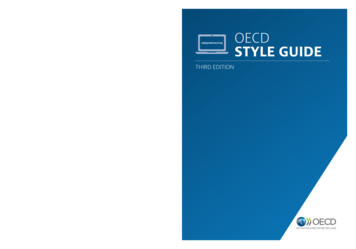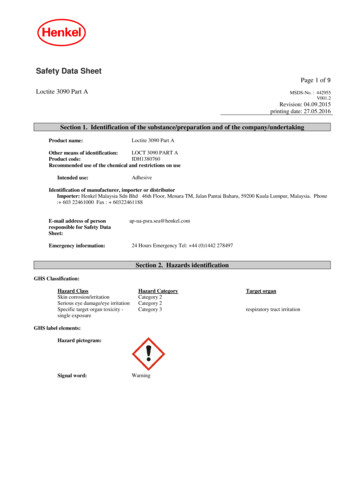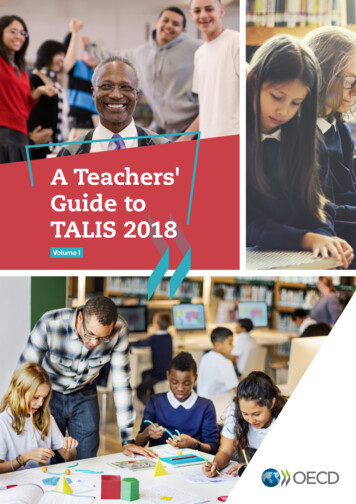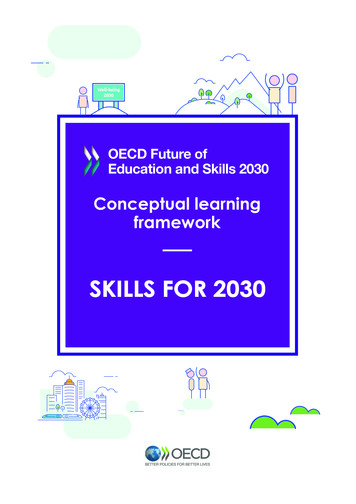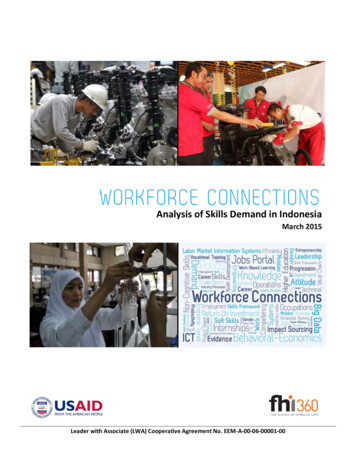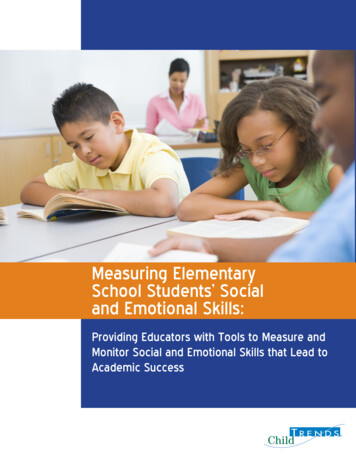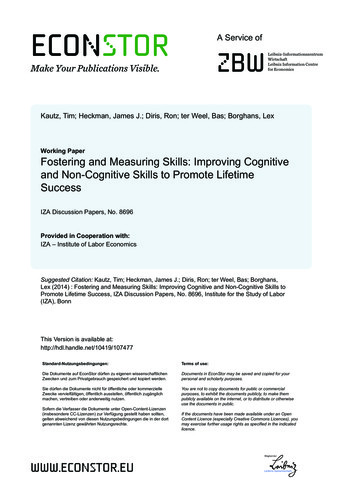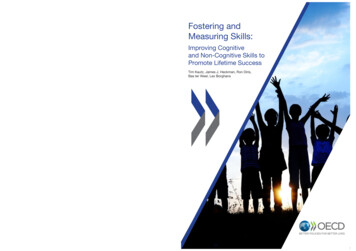
Transcription
Fostering andMeasuring Skills:Improving Cognitiveand Non-Cognitive Skills toPromote Lifetime SuccessTim Kautz, James J. Heckman, Ron Diris,Bas ter Weel, Lex BorghansDirectorate for Education and SkillsCentre for Educational Research and Innovation (CERI)Education and Social ogress.htm
FOSTERING AND MEASURING SKILLS:IMPROVING COGNITIVE ANDNON-COGNITIVE SKILLS TO PROMOTELIFETIME SUCCESS
This work is published under the responsibility of the Secretary-General of the OECD. The opinionsexpressed and arguments employed herein do not necessarily reflect the official views of OECD membercountries.This document and any map included herein are without prejudice to the status of or sovereignty over anyterritory, to the delimitation of international frontiers and boundaries and to the name of any territory, cityor area.Photo credits: ShutterstockYou can copy, download or print OECD content for your own use, and you can include excerpts fromOECD publications, databases and multimedia products in your own documents, presentations, blogs,websites and teaching materials, provided that suitable acknowledgment of the source and copyright owneris given. All requests for public or commercial use and translation rights should be submitted torights@oecd.org. Requests for permission to photocopy portions of this material for public or commercialuse shall be addressed directly to the Copyright Clearance Center (CCC) at info@copyright.com or theCentre français d’exploitation du droit de copie (CFC) at contact@cfcopies.com.
ACKNOWLEDGEMENTSThis report was commissioned by the OECD through its project on Education and SocialProgress.We thank Linor Kiknadze and Edward Sung for valuable research assistance. We received helpfulcomments from Richard Boyle, Zidi Chen, Maryclare Griffin, Robert Lerman, Seong HyeokMoon, Dan Moran, Maria Rosales, and Indra Wechsberg.3
TABLE OF CONTENTSEXECUTIVE SUMMARY .7INTRODUCTION .9Discarding Obsolete Notions and Embracing the Findings of Recent Research .11The Organisation of the Rest of the Paper .12MEASURES OF COGNITIVE AND NON-COGNITIVE SKILLS .13Cognitive Skills.13Measuring Non-cognitive Skills .13A Task-Based Framework for Identifying and Measuring Skills .16Reference Bias .18Measuring Skills Using Behaviours.20Are Non-Cognitive Skills Stable? .21THE PREDICTIVE POWER OF NON-COGNITIVE SKILLS .23Correlational Evidence.23Evidence from the General Educational Development (GED) Programme .25THE SKILLS NEEDED FOR SUCCESS IN THE LABOUR MARKET.29A FRAMEWORK FOR UNDERSTANDING INTERVENTIONS .31SUMMARY OF EMPIRICAL EVIDENCE ON THE EFFICACY OF INTERVENTIONS .33EARLY-LIFE INTERVENTIONS THAT BEGIN BEFORE FORMAL SCHOOLING.35Infant Programmes and Model Preschools .38Nurse-Family Partnership .38Jamaican Study.40Perry Preschool Programme .40Abecedarian Programme .42Large-Scale Infant and Young Child Programmes .43Head Start .43Chicago Child–Parent Center (CPC) .44EDUCATION AND INTERVENTIONS IN KINDERGARTEN AND ELEMENTARY SCHOOL .45Targeted Non-Cognitive Skill Interventions .45The Seattle Social Development Project (SSDP) .45The Montreal Longitudinal Experimental Study (MLES) .47Cambridge-Somerville Program.48Project STAR .48EDUCATION AND INTERVENTIONS TARGETED TOWARD ADOLESCENTS AND YOUNGADULTS .49Adolescent Mentorship Programmes .495
Quantum Opportunity Program .49Becoming a Man .50Pathways to Education Programme .50Big Brothers Big Sisters .51Empresários Pela Inclusão Social (EPIS) Program .51H&R Block FAFSA experiment .51Dartmouth College Coaching Program .52Residential-Based Programmes .52Job Corps .52National Guard ChalleNGe .52Workplace-Based Adolescent Intervention Programmes .53Career Academies .54Year-Up Programme .55Self-Sufficiency Project .56Apprenticeship Programmes .56OTHER CURRICULA THAT HAVE BEEN APPLIED TO MULTIPLE AGE GROUPS .59Tools of the Mind .59Studies that Teach the Incremental Theory of Intelligence .59Prevention vs. Remediation .60THE EFFECTS OF EDUCATION AND PARENTAL INVESTMENT ON COGNITIVE AND NONCOGNITIVE SKILL .61SUMMARY .66REFERENCES .67TablesTable 1.Table 2.Table 3.Table 4.Table 5.FiguresFigure 1.Figure 2.Figure 3.Figure 4.Figure 5.Figure 6.Figure 7.Figure 8.Figure 9.Figure 10.Figure 11.Figure 12.Figure 13.The Big Five Domains and Their Facets .15Summary of Effects for Main Interventions .36Summary of Effects of the Nurse-Family Partnership .39Summary of Treatment Effects from the Seattle Social Development Project .47Summary of Treatment Effects from Career Academies within 96-Month Follow-Up afterScheduled High School Graduation .55Determinants of Task Performance .16Decomposing Variance Explained for Achievement Tests and Grades into IQ and NonCognitive Skills: Stella Maris Secondary School, Maastricht, Holland .18National Rank in Big Five Conscientiousness and Average Annual Hours Worked .19Associations with Job Performance .23Correlations of Mortality with Non-Cognitive Skills, IQ, and Socioeconomic Status (SES) 24Distribution of Cognitive Ability by Educational Status (No College Sample, All EthnicGroups) .26Hourly Wage Differences of GED Recipients and Traditional Graduates Compared toUncertified Dropouts - Ages 20-39 .27Distribution of Non-Cognitive Skills by Education Group .28Framework for Understanding Skill Development .32Perry Preschool Program: IQ, by Age and Treatment Group.41Histograms of Indices of Non-Cognitive Skills and CAT Scores .42Casual Effect of Schooling on ASVAB Measures of Cognition .62Casual Effect of Schooling on Two Measures of Non-Cognitive Skill .636
EXECUTIVE SUMMARY1This paper reviews the recent literature on measuring and fostering cognitive and non-cognitive skills.IQ tests and achievement tests do not adequately capture non- cognitive skills personality traits, goals,character, motivations, and preferences that are valued in the labour market, in school, and in many otherdomains. For many outcomes, their predictive power rivals or exceeds that of cognitive skills.Evidence from the General Educational Development (GED) testing programme in the United Statesshows the importance of non-cognitive skills. The GED is an achievement test which dropouts can take tocertify that they are equivalent to secondary school graduates. The programme is based on the widely heldbelief that tests capture the important skills learned in school. On the surface, the programme is successful.Based on test scores, GED recipients are just as smart as high school graduates. When it comes tooutcomes that matter, such as college completion and labour market success, GED recipients performmuch worse in the labour market and in a variety of other life domains than traditional secondary schoolgraduates. Achievement tests like the GED do not adequately capture valuable non-cognitive skills. Thisevidence should cause policymakers to think twice about relying on achievement tests to evaluate theeffectiveness of educational systems.Reliable measures of non-cognitive skills are available, and they are discussed in this paper. Indeveloping any measure of non-cognitive skills, it is essential to recognise that all measures of skill arebased on performance of some task. Traditional personality tests are based on the performance of the taskof self-description. Performance on any task depends on multiple skills as well as the effort expended on it.Effort, in turn, depends on the incentives offered to exert the effort to perform the task. Since all measuresof cognitive and non-cognitive skill are measures of performance on some task, it is necessary tostandardise for incentives, effort, and other skills that determine performance on the task in measuring anyskill, yet this is rarely done in conducting skill assessments. Standard measures of cognitive skill have beenshown to be sensitive to incentives and levels of other skills. Test scores for young children can beimproved by one standard deviation by offering candy for correct answers. The responsiveness toincentives in turn depends on a child's levels of conscientiousness. Using measured behaviours to capturenon-cognitive skill is a promising approach that has been shown to be empirically effective. Such measuresare available in administrative data that are collected routinely by schools and government agencies.Skills are stable across situations with different incentives, although manifestations of skills vary withincentives. Though stable at any age, skills are not immutable traits that are set in stone over the life cycle.They have a genetic basis but are also shaped by environments, including families, schools, and peers.Skill development is a dynamic process. The early years are important in shaping all skills and in layingthe foundations for successful investment and intervention in the later years. During the early years, bothcognitive and non-cognitive skills are highly malleable. During the adolescent years, non-cognitive skillsare more malleable than cognitive skills. The differential plasticity of different skills by age has importantimplications for the design of effective policies.1Thispaper draws on Heckman and Kautz (2014a) and Heckman and Kautz (2014b).Kautz: Department of Economics, University of Chicago, 1126 E. 59th Street, Chicago IL 60637. Tel: 773702-0634. Email: tkautz@uchicago.edu. Heckman: Department of Economics, University of Chicago,1126 E. 59th Street, Chicago IL 60637; American Bar Foundation, 750 North Lake Shore Drive, Chicago,IL 60611; Institute for Fiscal Studies, University College London. Tel: 773-702-0634; Fax: 773-702-8490.Email: jjh@uchicago.edu. Diris: Research Centre of Public Economics, KU Leuven, Naamsestraat 69 Box 3565, 3000 Leuven Belgium. Ter Weel: CPB and Maastricht University, PO Box 80510, 2508 GMDen Haag, The Netherlands, b.ter.weel@cpb.nl. Borghans: Department of Economics and ROA,Maastricht University, PO Box 616, 6200 MD Maastricht, The Netherlands.7
This paper reviews a variety of interventions targeted to different stages of the life cycle. We interpretall of the studies we examine within an economic model of skill development. While it is difficult tocompare different interventions because they are often multifaceted and target different populations,nonetheless, four conclusions emerge.First, the evidence base is larger on the long-term effectiveness of interventions that start in earlychildhood and elementary school compared to their adolescent counter-parts. Many evaluations of earlyprogrammes measure a diverse set of outcomes and have follow-ups lasting more than 20 years. Evidenceon adolescent interventions is scarcer. Follow-ups for them are typically shorter and fewer outcomes areanalysed over shorter horizons. For this reason, we can draw stronger conclusions about the long-runefficacy of early programmes and how they work.Second, when evaluating skill enhancement programmes it is vital to consider outcomes other than IQor achievement test scores. Only interventions that start long before kindergarten begins have been shownto have long-term effects on IQ. If IQ were the only measure of success, most intervention programmeswould seem futile. Using a diverse set of outcomes presents a more optimistic point of view. Many earlyprogrammes improve later-life outcomes, even though they do not improve IQ.These programmes work because they foster non-cognitive skills. Some have annual rates of returnthat are comparable to those from investments in the stock market. Parental involvement is an importantcomponent of successful early interventions just as successful adolescent mentoring is an age-appropriateversion of parental involvement.Third, the available evidence suggests that the most successful adolescent remediation programmesare not as effective as the most successful early childhood and elementary school programmes, althoughadolescent mentoring and the provision of information can be very effective. Building an early base ofskills that promote later-life learning and engagement in school and society is often a better strategy thanwaiting for problems to occur. Prevention is more effective than remediation if at-risk populations aresufficiently well targeted.Fourth, adolescent remediation is possible for children who grow up in disadvantaged environmentsin their early years. The available evidence suggests that the most promising adolescent interventions arethose that target non-cognitive skills as well as programmes that offer mentoring, guidance andinformation. Many adolescent programmes that focus on academic skills or temporarily change aparticipant's environment are only successful in the short run although the short-term results can oftenappear to be spectacular. Workplace-based programmes that teach non-cognitive skills appear to beeffective remedial interventions for adolescents. They motivate acquisition of work-relevant skills andprovide for disadvantaged youth the discipline and guidance which is often missing in their homes or highschools. Successful interventions at any age emulate the mentoring and attachment that successful familiesgive their children.Skills enable people. They are capacities to function. Greater levels of skill foster social inclusion andpromote economic and social mobility. They generate economic productivity and create social well-being.Skills give agency to people to shape their lives, to create new skills and to flourish.8
INTRODUCTIONModern societies rely on written tests to sift and sort people, to evaluate students and schools, and toassess the performance of entire nations.2 Achievement tests play a prominent role. The OECD activelypromotes PISA tests. In the US, high school dropouts can take a 7-and-a-half hour achievement test – theGeneral Educational Development (GED) exam – to certify that they are equivalent to high schoolgraduates.3Despite their widespread use, achievement tests are not well understood and their creators were wellaware of their limitations (see the discussion in Heckman et al., 2014a). Achievement tests were developedin the mid-twentieth century as a way to measure a new concept – “general knowledge” – in an attempt tomeasure skills that are useful inside and outside of the classroom.4 Their developers thought that they haddesigned pencil-and-paper tests that would predict success in the labour market, in education, and in manyother aspects of life.Evaluation of the benefits of these tests is circular. Achievement tests are typically validated using IQtests and grades, and not by their ability to predict important life outcomes. Fortunately, a recent literaturehas conducted more meaningful evaluations of these tests and we report its findings here.Achievement test scores predict only a small fraction of the variance in later-life success. Forexample, adolescent achievement test scores only explain at most 17% of the variability in later-lifeearnings. 5 6 Measurement error accounts for at most 30% of the remaining variability (see Bound et al.,2001).Achievement tests do not adequately capture non-cognitive skills such as perseverance (“grit”),conscientiousness, self-control, trust, attentiveness, self-esteem and self-efficacy, resilience to adversity,openness to experience, empathy, humility, tolerance of diverse opinions and the ability to engageproductively in society, which are valued in the labour market, in school, and in society at large. Untilrecently these skills have largely been ignored in evaluations of schools and interventions. However, inrecent research economists and psychologists have constructed measures of these skills and providedevidence that they are stable across situations and predict meaningful life outcomes.72The Programme for International Student Assessment (PISA) evaluates student performance in maths, science, andreading across countries, and its results attract a lot of media attention and influence policy. Scores fromthe year 2000 PISA test led Germany to reevaluate its educational system and introduce a variety ofreforms (Grek, 2009). The creators of the original PISA tests called them literacy tests, not achievementtests, because PISA was designed to capture how knowledge can be applied to other contexts (OECD,2014). However, this was also the goal of the original achievement tests. We are unable to find any studiesestablishing that the original PISA measures were fundamentally different skills from those measured byachievement tests. Recently, however, PISA 2012 has added some component tests designed to captureaspects of non-cognitive skills including openness, locus of control, and motivation (OECD, 2013).3See Heckman et al. (2014a) for a detailed discussion of the GED program and an evaluation of its benefits.4For histories of achievement tests see Heckman and Kautz (2014c); Quinn (2014).5See Heckman and Kautz (2012). IQ tests alone explain at most 7% of this variability.6See Bound, Brown, and Mathiowetz (2001).7See the studies by Borghans, Duckworth, Heckman, and ter Weel (2008) and Almlund, Duckworth, Heckman, andKautz (2011). The modern literature traces back to Bowles and Gintis (1976), and Bowles, Gintis, andOsborne (2001). An important study in sociology is the work of Peter Mueser reported in Jencks (1979).9
Skills are not traits set in stone at birth and determined solely by genes. They can be fostered.Cognitive and non-cognitive skills change with age and with instruction. Interventions to improve skills areeffective to different degrees for different skills at different ages. Importantly, non-cognitive skills aremore malleable at later ages than cognitive skills.This paper reviews recent evidence from economics and personality psychology on the predictivepower of cognitive and non-cognitive skills and how to foster them. A growing body of empirical researchshows that non-cognitive skills rival IQ in predicting educational attainment, labour market success, health,and criminality.8 Both IQ and non-cognitive skills predict scores on achievement tests but non-cognitiveskills predict outcomes above and beyond their effects in predicting scores on achievement tests.9 Noncognitive skills are universally valued across all cultures, religions and societies.Because both cognitive and non-cognitive skills can be shaped and changed over the life cycle, theyare properly called skills. An older terminology in psychology refers to them as “traits,” conveying a senseof immutability or permanence, possibly due to their heritable nature. The distinction between skills andtraits is not just a matter of semantics. It suggests new and productive avenues for public policy.Skills enable people. They are capacities to function. Greater levels of skills foster social inclusionand promote economic and social mobility, economic productivity and well-being. Skills give people thetools with which to shape their lives, to create new skills and to flourish.There are reliable ways to measure skills, and there are proven ways to enhance them and to evaluateefforts to foster them. Recent research establishes the existence of critical and sensitive periods in theformation of skills over the life cycle. Sensitive periods are those periods where investment is especiallyproductive; critical periods are those periods when investment is essential. Critical and sensitive periodsdiffer across skills. Investments should target those periods.Effective strategies for promoting human development are based on three guiding principles:1.The powerful role of families and general social environments in shaping skills.2.The multiplicity of skills required for successful functioning in society. A core set of skillspromotes success in many aspects of life. Different tasks require different skills in different levelsand proportions. Successful people pursue the tasks where their skills give them comparativeadvantage along with personal satisfaction.3.The technology of skill formation: that skills together with investments beget further skills(Cunha and Heckman, 2007, 2008; Cunha, Heckman, and Schennach, 2010).Effective policies to promote skills straddle the missions of cabinet agencies and draw on the wisdomof many academic disciplines. They require broad thinking and recognition that both cognitive and noncognitive skills are important ingredients of successful lives and are malleable to different degrees atdifferent stages of the life cycle. They recognise that different skills cross-fertilise each other. Focusing onWork in psychology going back to Terman, Baldwin, Bronson, DeVoss, Fuller, Lee Kelley, Lima,Marshall, Moore, Raubenheimer, Ruch, Willoughby, Benson Wyman, and Hazeltine Yates (1925) showsthat personality skills predict life outcomes (see also Murray, 1938; Terman, Oden, Bayley, Marshall,McNemar, and Sullivan, 1947; and the analysis in Gensowski, 2014).8See Heckman and Kautz (2012, 2014a, 2014c), Almlund et al. (2011), Borghans et al. (2008), and Roberts, Kuncel,Shiner, Caspi, and Goldberg (2007) for reviews.9See Kautz and Zanoni (2014).10
one dimension of human skills to the exclusion of other dimensions or on one stage of the life cycle to theexclusion of others misses fundamental aspects of human performance and development. Narrowlyfocused policies fail to capture synergisms in the expression and development of skills.Policymakers in the OECD share a common desire to develop human potential. However, currentdiscussions focus on promoting skills by improving schools. Within this very narrow purview, the successof schools is measured by scores on the exams of the students in them. This mindset is a consequence ofvery limited conceptualisations of human capabilities that assumes that achievement tests capture theimportant life skills. It misses important dimensions of human flourishing. While schools are important,they are far from being the principal source of the skills that matter.Discarding Obsolete Notions and Embracing the Findings of Recent ResearchIn designing effective human development strategies, it is essential to discard obsolete views aboutthe origin and malleability of “traits.” What used to be regarded as traits fixed at conception are nowunderstood to be skills that can be augmented through guidance and instruction. Raw intelligence is notfixed solely by parental genes, although heritability plays an important role in shaping it. It is boosted byquality parenting and by caring environments. It becomes solidified around the time of puberty.Non-cognitive skills can also be shaped. Compared to raw intelligence, they are more malleable untillater ages. Neuroscience shows that this malleability is associated with the slow development of theprefrontal cortex.10When attempted, adolescent remediation should focus on boosting non-cognitive skillsby effective mentoring and guidance.Skill development is a dynamic process. Boosting non-cognitive skills early in life increases thebenefits of education later in life. More persistent students learn more. The levels of cognitive and noncognitive skills at any age depend in part on levels of those skills at younger ages which depend on earlierinvestments.11Inequality among families in parenting and lack of support given to children in schools are majorcontributors to inequality in adult skills. In light of this evidence, it is of great concern that so manychildren a
Skills are stable across situations with different incentives, although manifestations of skills vary with incentives. Though stable at any age, skills are not immutable traits that are set in stone over the life cycle. They have a genetic basis but are also shaped by environments, including families, schools, and peers.
